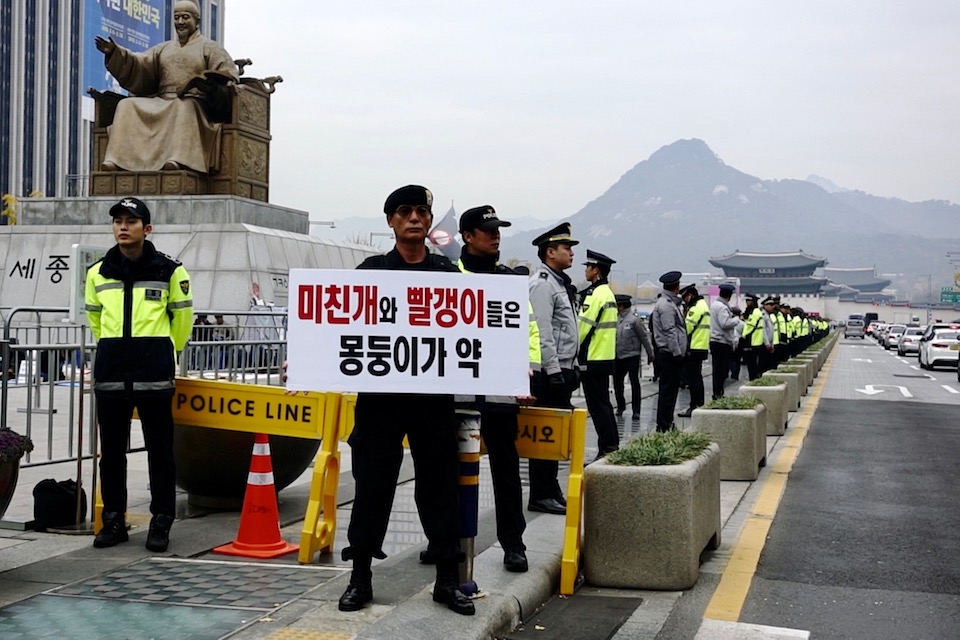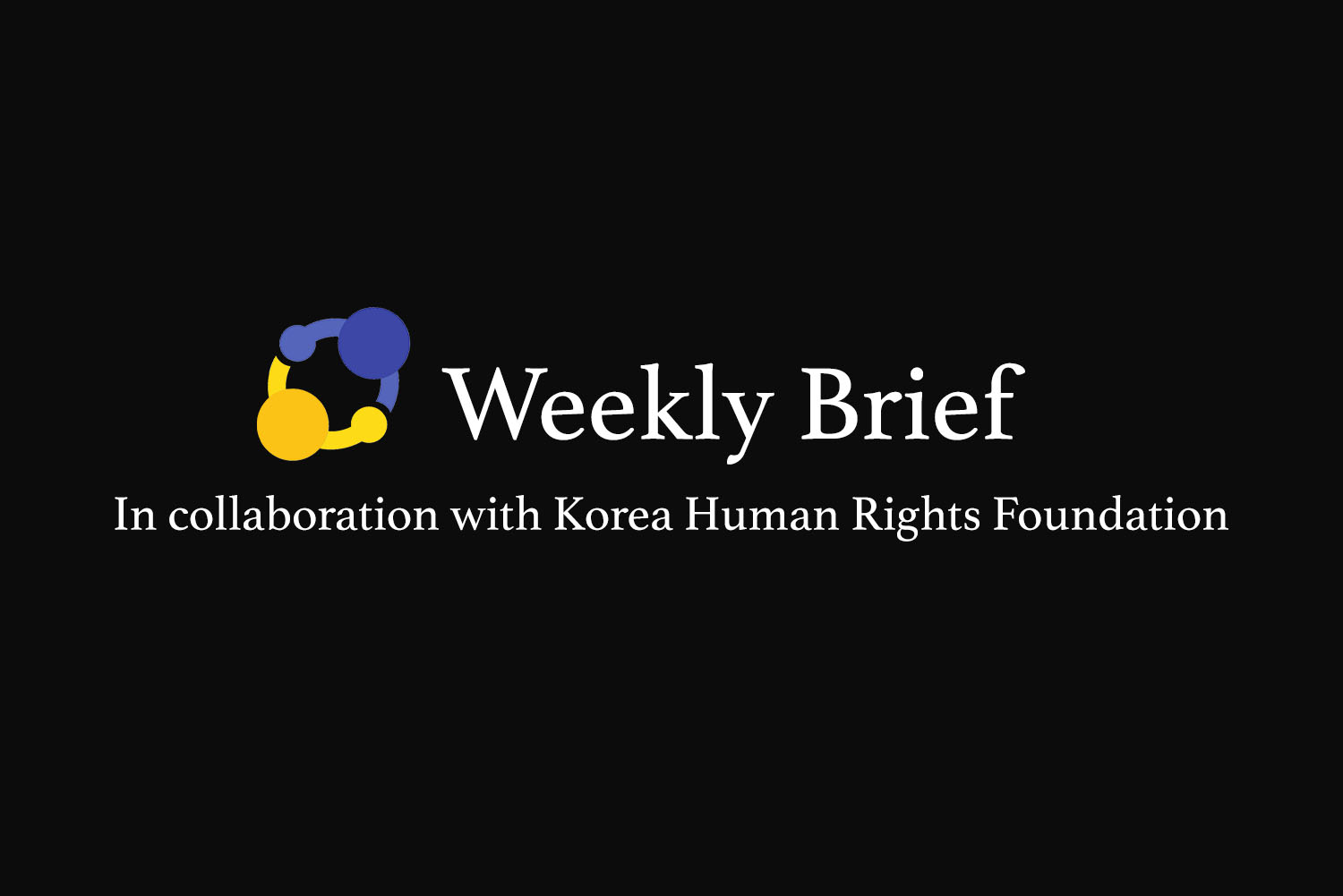
Dispatch: Central Seoul Quiet as Trump Arrives for Meeting with "a Fine Gentleman"
Walking through central Seoul on Tuesday morning, it’s clear that the South Korean government is taking no chances with security during U.S. President Donald Trump’s visit. In the vicinity of Gwanghwamun Square, Seoul’s symbolic center, police line the street and stand shoulder to shoulder at every intersection.
The police vastly outnumber the protesters they are assigned to keep in line — over 15,000 in downtown Seoul, according to the Seoul Metropolitan Police Agency. Despite initial reports that dozens of protests were scheduled for Tuesday, at least as of this morning, only a few dozen of the most dedicated have turned out, and the road leading to the presidential office is entirely blocked off by police.
The main square is almost entirely sectioned off, with small clusters of protesters off to the side, roughly equal numbers welcoming and decrying Trump’s visit.
Kim Hye-min, 33, is a member of a group of young South Koreans who recently attempted to travel to the U.S. to protest Trump on his own soil, but were reportedly turned away at the airport and denied entry to the U.S. After that planned trip came to naught, Kim and her fellow protesters have for the past two weeks protested outside the U.S. embassy in Seoul, across the street from Gwanghwamun.
Kim says her organization, called the Fellowship of South Korean Youth, sees Trump’s visit as heightening the risk of war with North Korea. “We don’t want Trump to come to Korea because he always provokes the world,” Kim tells Korea Exposé.
“He says he doesn’t care if there are thousands of deaths over here, on the Korean peninsula,” she adds.

Before leaving for South Korea, Trump tweeted that he would be holding meetings with South Korean President Moon Jae-in, whom Trump described as “a fine gentleman.” With that polite choice of words, Trump was careful not to repeat the mistake of his predecessor George W. Bush, who in 2001 committed a faux pas in South Korea by referring to his counterpart Kim Dae-jung as “this man,” phrasing that comes across as rude in Korean translation.
The delicate wording illustrates the sensitivity surrounding the trip. The talk between Trump and South Korean President Moon Jae-in is expected to focus on North Korea and how the two longtime allies can contain it.
On Trump’s itinerary for the first day of his visit is a trip to Camp Humphreys military base in Pyeongtaek, about an hour south of Seoul. The base is currently in the midst of a large scale expansion, which will make it the largest U.S. base in South Korea, and a growing focal point of the American military’s presence in Asia.
Troops are being relocated from Yongsan Garrison in Seoul, which occupies prime real estate, and other bases north of the city, in a project that has been called “the largest construction project in the history of the Department of Defense.” Construction project costs are an estimated $10.8 billion, 92 percent of which is being covered by the South Korean government.

Some South Koreans, especially on the political left, oppose this close military alliance. But on the other side of the square, and the political spectrum, a group of middle-aged men and women have come to the scene holding American and South Korean flags and pro-Trump placards. Many of the men are dressed in military fatigues.
“These crazy bastards are protesting the U.S. president’s visit!” says Moon Byung-so, in a tone of indignation, referring to the left-wing protesters. Moon is a member of a military veterans’ group whose main objective is convincing the world that the democracy uprising that took place in Gwangju in 1980 was the work of North Korean agents (a theory that has scant evidence to support it).
Moon’s colleagues are carrying an array of placards that not only welcome Trump but heap scorn on the left-wing groups protesting his visit. “Crazy dogs and commies deserve a beating,” reads one. “Decapitate Kim Jong-un right away!” reads another.
Heo Yeon, another right-wing protester, motions at the left wingers across the street and says, “These are the same people who are responsible for Park Geun-hye’s impeachment,” as if Park’s impeachment were self-evidently a bad thing.
Trump will be in South Korea until tomorrow, when he is scheduled to address the National Assembly. In his remarks, Trump is expected to comment on standing firm against North Korea and the need to uphold the U.S.-South Korea alliance. He could also mention his desire to renegotiate the South Korea-U.S. Free Trade Agreement, which he has called a “horrible” deal. (On Monday, his second day of visit to Tokyo, he accused Japan of unfair trade practices.)
The government of President Moon, who as a former human rights lawyer and progressive activist has a very different background from Trump’s, is working to ensure Trump’s visit goes ahead smoothly, regarding both logistics and the policy positions the two leaders communicate. Despite having come into office pledging a softer line on North Korea, Moon has of late basically concurred with Trump’s tougher approach.
Throughout the rest of Trump’s time in the country, Gwanghwamun will likely remain in some state of lockdown as South Koreans come out to publicly air their feelings about their country’s complex relationship with the U.S.
Cover image: Police and right-wing activists in central Seoul’s Gwanghwamun Square on the morning of U.S. President Donald Trump’s state visit, Nov. 7, 2017. The placard reads, “Crazy dogs and commies deserve a beating.” (Jieun Choi/Korea Exposé)

